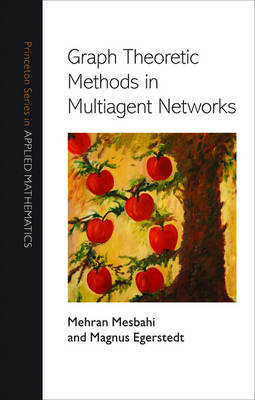Princeton Series in Applied Mathematics
2 total works
Graph Theoretic Methods in Multiagent Networks
by Mehran Mesbahi and Magnus Egerstedt
Published 1 January 2010
This accessible book provides an introduction to the analysis and design of dynamic multiagent networks. Such networks are of great interest in a wide range of areas in science and engineering, including: mobile sensor networks, distributed robotics such as formation flying and swarming, quantum networks, networked economics, biological synchronization, and social networks. Focusing on graph theoretic methods for the analysis and synthesis of dynamic multiagent networks, the book presents a powerful new formalism and set of tools for networked systems. The book's three sections look at foundations, multiagent networks, and networks as systems. The authors give an overview of important ideas from graph theory, followed by a detailed account of the agreement protocol and its various extensions, including the behavior of the protocol over undirected, directed, switching, and random networks. They cover topics such as formation control, coverage, distributed estimation, social networks, and games over networks.
And they explore intriguing aspects of viewing networks as systems, by making these networks amenable to control-theoretic analysis and automatic synthesis, by monitoring their dynamic evolution, and by examining higher-order interaction models in terms of simplicial complexes and their applications. The book will interest graduate students working in systems and control, as well as in computer science and robotics. It will be a standard reference for researchers seeking a self-contained account of system-theoretic aspects of multiagent networks and their wide-ranging applications. This book has been adopted as a textbook at the following universities: * University of Stuttgart, Germany * Royal Institute of Technology, Sweden * Johannes Kepler University, Austria * Georgia Tech, USA * University of Washington, USA * Ohio University, USA
And they explore intriguing aspects of viewing networks as systems, by making these networks amenable to control-theoretic analysis and automatic synthesis, by monitoring their dynamic evolution, and by examining higher-order interaction models in terms of simplicial complexes and their applications. The book will interest graduate students working in systems and control, as well as in computer science and robotics. It will be a standard reference for researchers seeking a self-contained account of system-theoretic aspects of multiagent networks and their wide-ranging applications. This book has been adopted as a textbook at the following universities: * University of Stuttgart, Germany * Royal Institute of Technology, Sweden * Johannes Kepler University, Austria * Georgia Tech, USA * University of Washington, USA * Ohio University, USA
Splines, both interpolatory and smoothing, have a long and rich history that has largely been application driven. This book unifies these constructions in a comprehensive and accessible way, drawing from the latest methods and applications to show how they arise naturally in the theory of linear control systems. Magnus Egerstedt and Clyde Martin are leading innovators in the use of control theoretic splines to bring together many diverse applications within a common framework. In this book, they begin with a series of problems ranging from path planning to statistics to approximation. Using the tools of optimization over vector spaces, Egerstedt and Martin demonstrate how all of these problems are part of the same general mathematical framework, and how they are all, to a certain degree, a consequence of the optimization problem of finding the shortest distance from a point to an affine subspace in a Hilbert space. They cover periodic splines, monotone splines, and splines with inequality constraints, and explain how any finite number of linear constraints can be added.
This book reveals how the many natural connections between control theory, numerical analysis, and statistics can be used to generate powerful mathematical and analytical tools. This book is an excellent resource for students and professionals in control theory, robotics, engineering, computer graphics, econometrics, and any area that requires the construction of curves based on sets of raw data.
This book reveals how the many natural connections between control theory, numerical analysis, and statistics can be used to generate powerful mathematical and analytical tools. This book is an excellent resource for students and professionals in control theory, robotics, engineering, computer graphics, econometrics, and any area that requires the construction of curves based on sets of raw data.

